| Vasily Vereshchagin | |
|---|---|
| Василий Верещагин | |
 | |
| Born | (1842-10-26)26 October 1842 Cherepovets, Novgorod Governorate, Russian Empire |
| Died | 13 April 1904(1904-04-13) (aged 61) Port Arthur, Russian Empire (now Lüshunkou, China) |
| Nationality | Russian |
| Alma mater | St. Petersburg Academy of Arts |
| Occupations |
|
| Notable work | The Apotheosis of War (1871) Suppression of the Indian Revolt by the English (1884) |
| Style | Realism |
| Awards | Order of St. George (4th Class) |
Vasily Vasilyevich Vereshchagin (Russian: Васи́лий Васи́льевич Вереща́гин; 26 October 1842 – 13 April 1904) was a Russian painter, war artist, and traveller. The graphic nature of his realist scenes led to many of them never being printed or exhibited to the public.
Years of apprenticeship

Vereshchagin was born at Cherepovets, Novgorod Governorate, Russia, in 1842 as the middle of three brothers. His father was a landowner of noble birth, while his mother was of common origin and had Tatar roots. When he was eight years old, he was sent to Tsarskoe Selo to enter the Alexander Cadet Corps. Three years later, he entered the Naval Cadet Corps at St. Petersburg, making his first voyage in 1858. He served on the frigate Kamchatka, which sailed to Denmark, France, and Egypt.
Vereshchagin graduated first in his list at the naval school, but left the service immediately to begin the study of drawing in earnest. Two years later, in 1863, he won a medal from the Imperial Academy of Arts for his Ulysses Slaying the Suitors. In 1864, he proceeded to Paris, where he studied under Jean-Léon Gérôme, though he dissented widely from his master's methods.
Travels in Central Asia
In the Paris Salon of 1866, Vereshchagin exhibited a drawing of Dukhobors chanting their Psalms. In the next year, he was invited to accompany General Konstantin Petrovich Kaufman's expedition in Central Asia and Turkestan. He was granted the rank of ensign. His heroism at the siege of Samarkand from 2–8 June 1868 resulted an award of the Cross of St. George (4th Class). He was an indefatigable traveller, returning to St. Petersburg in late 1868, to Paris in 1869, back to St. Petersburg later in the year, and then back to Turkestan via Siberia at the end of 1869.
In 1871, Vereshchagin established an atelier in Munich, German Empire. He gave a solo exhibition of his works (later referred to as his "Turkestan Series") at the Crystal Palace in London, United Kingdom in 1873. He gave another exhibition of his works in St. Petersburg in 1874, where two of his paintings, namely, The Apotheosis of War, dedicated "to all conquerors, past, present and to come," and Left Behind, the picture of a dying soldier deserted by his fellows, were denied a showing on the grounds that they portrayed the Russian military in a poor light. In late 1874, Vereshchagin departed in Northern and Eastern Asia for an extensive tour of the Himalayas, British India, Mongolia, and Tibet, spending over two years in travel. He returned to Paris in late 1876.
- The early works
-
 Lully (Gypsy) (1867–1868)
Lully (Gypsy) (1867–1868)
-
 Portrait of a man in a white turban (1867)
Portrait of a man in a white turban (1867)
-
 Uzbek boy (1867–1868)
Uzbek boy (1867–1868)
-
 Dervishes in festive outfits (1869–1870)
Dervishes in festive outfits (1869–1870)
-
 Kalmyk chapel (1869–1870)
Kalmyk chapel (1869–1870)
-
The Apotheosis of War (1871)
-
 Sale of a child-slave (1872). A rich Turkish man examines a naked boy, before buying him.
Sale of a child-slave (1872). A rich Turkish man examines a naked boy, before buying him.
-
 Mullah Rahim and Mullah Kerim on his way to the bazaar are quarreling (1873)
Mullah Rahim and Mullah Kerim on his way to the bazaar are quarreling (1873)
-
 Main Street in Samarkand, from the height of the citadel in the early morning (1869–1870)
Main Street in Samarkand, from the height of the citadel in the early morning (1869–1870)
-
 Shah-i-Zinda Mausoleum in Samarkand (1869–1870)
Shah-i-Zinda Mausoleum in Samarkand (1869–1870)
-
 Gur-e-Amir mausoleum. Samarkand (1869–1870)
Gur-e-Amir mausoleum. Samarkand (1869–1870)
-
They are triumphant (1872). Registan. The Emir of Bukhara and the city's notables watch how the heads of Russian soldiers are impaled on poles.
-
 Sher-Dor Madrasa on Registan Square in Samarkand (1869–1870)
Sher-Dor Madrasa on Registan Square in Samarkand (1869–1870)
-
Presentation of the trophies (1872)
-
 Fakir (1874–1876)
Fakir (1874–1876)
-
 Buddhist temple in Darjiling. Sikkim (1874)
Buddhist temple in Darjiling. Sikkim (1874)
-
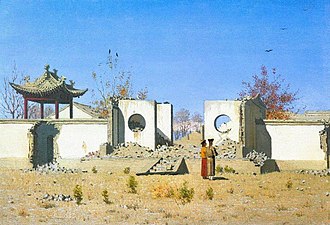 Ruins of Chinese sanctuary. Ak-Kent (1869–1870)
Ruins of Chinese sanctuary. Ak-Kent (1869–1870)
-
 Chinese house (1869–1870)
Chinese house (1869–1870)
-
 Ruins of a Theater in Chuguchak (1869–1870)
Ruins of a Theater in Chuguchak (1869–1870)
-
 A Garden gate in Chuguchak (1869–1870)
A Garden gate in Chuguchak (1869–1870)
-
Ruins in Chuguchak (1869–1870)
-
 Ruins in Chuguchak (1869–1870)
Ruins in Chuguchak (1869–1870)
-
 Chinese tent (1869–1870)
Chinese tent (1869–1870)
-
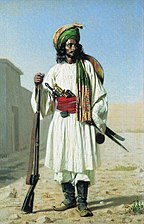 Afghan (1868)
Afghan (1868)
-
 Afghan (1869–1870)
Afghan (1869–1870)
-
 After a success (1868)
After a success (1868)
-
 After an unsuccess (1868)
After an unsuccess (1868)
-
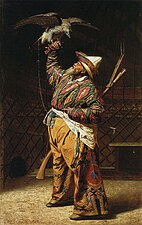 A rich Kyrgyz hunter with a falcon (1871)
A rich Kyrgyz hunter with a falcon (1871)
-
 Kyrgyz yurts on the Chu River (1869–1870)
Kyrgyz yurts on the Chu River (1869–1870)
-
 Inside the tent of a rich Kyrgyz (1869–1870)
Inside the tent of a rich Kyrgyz (1869–1870)
-
 Oirat (Kalmyk) Lama wearing a ritual headdress (1869–1870)
Oirat (Kalmyk) Lama wearing a ritual headdress (1869–1870)
-
 In the Alatau Mountains (1869–1870)
In the Alatau Mountains (1869–1870)
-
 In the Alatau Mountains (1869–1870)
In the Alatau Mountains (1869–1870)
-
 Nomadic road in the Alatau Mountains (1869–1870)
Nomadic road in the Alatau Mountains (1869–1870)
-
 Kyrgyz migration (1869–1870)
Kyrgyz migration (1869–1870)
-
 Barskaun Passage [ky] (1869–1870)
Barskaun Passage [ky] (1869–1870)
-
 The children of the Solon tribe (1869–1870)
The children of the Solon tribe (1869–1870)
-
 Timur's (Tamerlane's) doors (1872)
Timur's (Tamerlane's) doors (1872)
-
 Opium-eaters (1868)
Opium-eaters (1868)
-
 Politicians in opium shop. Tashkent (1870)
Politicians in opium shop. Tashkent (1870)
-
 By the Fortress Wall. "Let Them Enter" (1871)
By the Fortress Wall. "Let Them Enter" (1871)
-
 Surprise Attack (1871)
Surprise Attack (1871)
-
 Parlimentaires. "Surrender!" — "Get the hell out!"
Parlimentaires. "Surrender!" — "Get the hell out!"
Russo-Turkish War
With the start of the Second Russo-Turkish War, Vereshchagin left Paris and returned to active service with the Imperial Russian Army. He was present at the crossing of the Shipka Pass and at the siege of Plevna (1877), where his brother was killed. He was dangerously wounded during the preparations for the crossing of the Danube near Rustchuk. At the conclusion of the war, he acted as secretary to General Skobelev at San Stefano.
World fame
After the war, Vereshchagin settled in Munich, where he produced his war pictures so rapidly that he was freely accused of employing assistants. The sensational subjects of his pictures, and their didactic aim, namely, the promotion of peace by a representation of the horrors of war, attracted a large section of the public not usually interested in art to the series of exhibitions of his pictures in Paris in 1881, and subsequently in London, Berlin, Dresden, Vienna, and other cities.

Vereshchagin painted several scenes of imperial rule in British India. His epic portrayal of The State Procession of the Prince of Wales into Jaipur in 1876 is at 196 in × 274 in believed to be the second-largest oil painting in the world. He traveled again to India in 1882–1883.
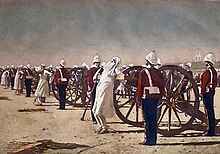
He aroused much controversy by his series of three pictures: firstly, of a Roman execution (the Crucifixion by the Romans (1887)); secondly, Suppression of the Indian Revolt by the English; and, thirdly, of the execution of Nihilists in St Petersburg. When Suppression of the Indian Revolt by the English was first exhibited, many in America and Britain believed that it depicted executions of sepoys carried out by tying victims to the barrels of guns. Vereshchagin's detractors argued that such executions had only occurred in the Indian Rebellion of 1857, but the painting depicted modern soldiers of the 1880s, implying that the practice was then current. Because of its photographic style, the painting appeared to present itself as an impartial record of a real event. In fact, Vereshchagin's work did show a more contemporary though lesser known execution; in 1872 Deputy-Commissioner J. L. Cowan ordered the execution of a group of Namdhari Sikhs at the parade grounds in Malerkotla by blowing from guns. In 1887, Vereshchagin defended himself in The Magazine of Art by saying that if there were another rebellion then the British would use this method again.
A journey to the Ottoman provinces of Syria and Palestine in 1884 furnished him with an equally discussed set of subjects from the New Testament. Vereshchagin's paintings caused controversy over his portrayal of the figure of Christ with what was thought at the time to be an unseemly realism. The 1812 series on Napoleon's Russian campaign, on which Vereshchagin also wrote a book, seems to have been inspired by Tolstoi's War and Peace, and was painted in 1893 in Moscow, where the artist eventually settled.

Last years


Vereshchagin was in the Far East during the First Sino-Japanese War of 1894–1895, and was with the Russian troops in Manchuria during the Boxer Rebellion of 1900. In 1901, he visited the Philippines, in 1902 the United States and Cuba, and in 1903, Japan.
During the Russo-Japanese War, he was invited by Admiral Stepan Makarov to join him aboard Makarov's battleship, Petropavlovsk. On April 13, 1904, Petropavlovsk struck two mines while returning to Port Arthur and sank, taking with it most of the crew, including both Admiral Makarov and Vereshchagin. Vereshchagin's last work, a picture of a council of war presided over by Admiral Makarov, was recovered almost undamaged.
Legacy
- The town of Vereshchagino in Perm Krai is named after him, as well as a minor planet, 3410 Vereshchagin, discovered by Soviet astronomer Lyudmila Zhuravlyova in 1978.
- Vereshchagin Street in Cherepovets is named after Vasily Vereshchagin, also there are a historic house museum and a monument to Vereshchagin in Cherepovets.
- He is a distant relative of the Czech rock singer Aleš Brichta. The Apotheosis of War was used by Czech heavy metal band Arakain as the cover art for the album Farao.
Gallery
- Napoleon. 1812
-
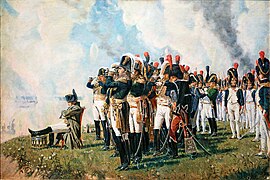 Napoleon near Borodino
Napoleon near Borodino
-
 The end of Borodino battle
The end of Borodino battle
-
 Before Moscow waiting for the Boyars' Deputation
Before Moscow waiting for the Boyars' Deputation
-
 In Defeated Moscow
In Defeated Moscow
-
 Through the fire
Through the fire
-
 In Petrovsky Palace (Waiting for peace)
In Petrovsky Palace (Waiting for peace)
-
 Vereshchagin with his wife Lydia and son Vasily at the In Petrovsky Palace painting. 1895–1896
Vereshchagin with his wife Lydia and son Vasily at the In Petrovsky Palace painting. 1895–1896
-
Napoleon and general Lauriston (Peace at all costs!)
-
 On the high road. Retreat, flight
On the high road. Retreat, flight
-
 Fix Bayonets! Hooray! Hooray! (the Battle of Krasnoi)
Fix Bayonets! Hooray! Hooray! (the Battle of Krasnoi)
-
 Night Bivouac of Great Army
Night Bivouac of Great Army
- Balkan series
-
 Victors
Victors
-
 Before the attack. At Plevna
Before the attack. At Plevna
-
 After the Attack
After the Attack
-
The battlefield at Shipka (Skobelev at Shipka)
-
 Defeated. Requiem
Defeated. Requiem
-
 The Spy
The Spy
-
 Picket on the Danube
Picket on the Danube
-
 Two hawks (Bashi-bazouk)
Two hawks (Bashi-bazouk)
-
 In a Turkish mortuary
In a Turkish mortuary
-
 The Adjutant
The Adjutant
- Other works
-
 The Moscow Cathedrals and river Moskva (in the spring)
The Moscow Cathedrals and river Moskva (in the spring)
-
 Eagles (A forgotten soldier)
Eagles (A forgotten soldier)
-
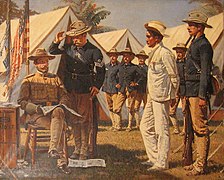 Spy (Spanish–American War)
Spy (Spanish–American War)
-
 Interrogation of a deserter
Interrogation of a deserter
-
 Shinto shrine in Nikkō
Shinto shrine in Nikkō
-
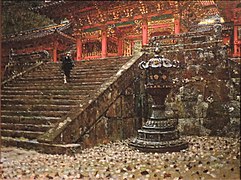 Shrine in Nikkō
Shrine in Nikkō
-
 Japanese woman
Japanese woman
See also
Further reading
- Verestchagin, Vassili (1887). Vassili Verestchagin, Painter, soldier, Traveler; Autobiographical Sketches. Vol. 1. Translated by Peters, F. H. London: Richard Bentley & Son. Retrieved 14 August 2018 – via Internet Archive.; Verestchagin, Vassili (1887). Vassili Verestchagin, Painter, soldier, Traveler; Autobiographical Sketches. Vol. 2. Translated by Peters, F. H. London: Richard Bentley & Son. Retrieved 14 August 2018 – via Internet Archive.
- Verestchagin, Vassili (1889–1890). Realism. Translated by Mrs. MacGahan. Special Exhibition; Inter-state Industrial Exposition of Chicago. Retrieved 14 August 2018 – via Internet Archive.
- Verestchagin, Vassili (1899). "1812" Napoleon I in Russia; with an Introduction by R. Whiteing. London: William Heinemann. Retrieved 14 August 2018 – via Internet Archive.
- Pleshakov, Constantine. "The Tsar's Last Armada-The Epic Voyage to the Battle of Tsushima." (2002).
Notes
- Kowner, Historical Dictionary of the Russo-Japanese War, p. 408.
- ^ Chisholm, Hugh, ed. (1911). "Vereshchagin, Vassili Vassilievich" . Encyclopædia Britannica. Vol. 27 (11th ed.). Cambridge University Press. p. 1021.
- Heather S. Sonntag, Tracing the Turkestan Series – Vasily Vereshchagin's Representations of Late-19th-century Central Asia, University of Wisconsin-Madison (2003), p. 18
- Vladimir Visson, Portraits of Russian Painters, V. Visson (1987), p. 72
- Chitralekha (2020-06-02). "The 'Jaipur Procession' that inspired the world's second largest oil painting". The Heritage Lab. Retrieved 2023-12-04.
- Basu, Anasuya (2022-09-04). "War Painter: Russia attacks Ukraine: time to remember a 19th century Russian artist Vasily Vasilyevich Vereshchagin". The Telegraph Online. Retrieved 2023-12-04.
- Webley, John (2023)."The Orient estranged: Vasilii Vereshchagin’s Blowing from Guns in British India" Russian Orientalism in a Global Context Manchester: Manchester University Press: 120-142
- "Art in December: M. Verestchagin on his Critics – Art and Politics". The Magazine of Art. November 1887 – October 1888. 11. Cassell: ix (following p. 430). 1878–1904.
- Verestchagin, Vassili (1899). "1812" Napoleon I in Russia; with an Introduction by R. Whiteing. London: William Heinemann. Retrieved 14 August 2018 – via Internet Archive.
- "State Historical Museum Opens 'The Year 1812 in the Paintings by Vasily Vereshchagin'," Art Daily, March 11, 2010; "War Lasted 18 Months ... Russian Miscalculation," New York Times, August 30, 1905.
- Directory of Minor Plant Names.
- "Василий Васильевич Верещагин, цикл полотен «1812 год»". www.museum.ru. Retrieved 2024-04-12.
References
 This article incorporates text from a publication now in the public domain: Chisholm, Hugh, ed. (1911). "Vereshchagin, Vassili Vassilievich". Encyclopædia Britannica. Vol. 27 (11th ed.). Cambridge University Press. p. 1021.
This article incorporates text from a publication now in the public domain: Chisholm, Hugh, ed. (1911). "Vereshchagin, Vassili Vassilievich". Encyclopædia Britannica. Vol. 27 (11th ed.). Cambridge University Press. p. 1021.- Barooshian, Vahan D. (1993). V.V. Vereshchagin: Artist at War. Gainesville, FL: University Press of Florida. ISBN 0-8130-1178-7 – via Internet Archive.
- Kowner, Rotem (2006). "Historical Dictionary of the Russo-Japanese War". Scarecrow. 620pp. ISBN 0-8108-4927-5
- Leonard D. Abbott, "Verestchagin, Painter of War." The Comrade (New York), vol. 1, no. 7 (April 1902), pp. 155–156.
- Art Institute of Chicago, Works of Vassili Verestchagin: an Illustrated, descriptive catalogue and two appendixes to the catalogue Realism and Progress in Art by Verestchagin.
- W. T. Stead, "Vassili Verestchagin: Character Sketch," Review of Reviews (London), vol. 19 (January 1899), frontispiece, 22–33.
- Maria Chernysheva, "The Russian Gérôme? Vereshchagin as a Painter of Turkestan," RIHA Journal, September 2014.
External links
 Media related to Vasily Vereshchagin at Wikimedia Commons
Media related to Vasily Vereshchagin at Wikimedia Commons- Vasily Vasilyevich Vereshchagin at the Web Gallery of Art
- Vereshchagin page at Olga's Gallery
- Vasily Vereshchagin: horrors of war through artist’s eyes
- Vereshchagin's lost paintings Archived 2008-12-08 at the Wayback Machine
- Works by Vasily Vereshchagin at Project Gutenberg
- Artworks by or after Vasily Vereshchagin at the Art UK site
- 1842 births
- 1904 deaths
- 19th-century painters from the Russian Empire
- 19th-century war artists
- 20th-century Russian painters
- 20th-century war artists
- Expatriates in British India
- Imperial Academy of Arts alumni
- Male painters from the Russian Empire
- Naval Cadet Corps alumni
- Orientalist painters from the Russian Empire
- Painters from Saint Petersburg
- People from Cherepovets
- People from the Russian Empire of Tatar descent
- Realist painters from the Russian Empire
- Recipients of the Order of St. George of the Fourth Degree
- Russian military personnel killed in the Russo-Japanese War
- Russian military personnel of the Russo-Turkish War (1877–1878)
- War artists from the Russian Empire